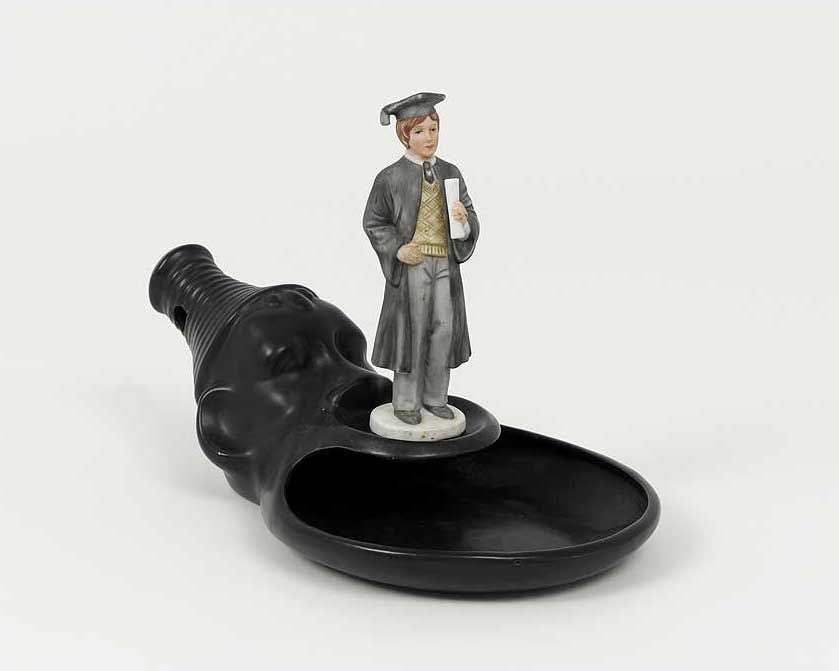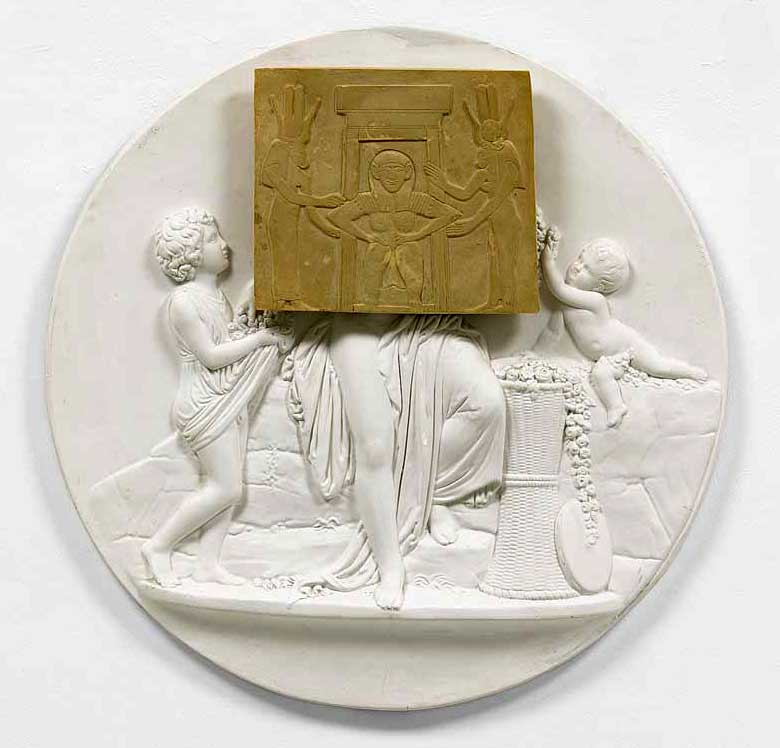Interview
Beauty & Memory

Fred Wilson. Untitled (Eye), 1992. Plaster; 11 1/2 X 10 X 3 3/4 inches. Installation view at Metro Pictures, New York. Courtesy of Pace Gallery, New York.
Fred Wilson discusses the power of beauty, and the conceptual matrices behind each of his works.
ART21: You work in a variety of mediums: installation, sculpture, video, glass, printmaking . . .
WILSON: For the ideas that I have, it’s more important that they’re done the way I envision them. What’s great about printmaking is that you can make so many of them and really share them with the world. And the process—that’s really interesting to me. The result is not like anything else. But I’m not a printmaker. I don’t feel like I need to make prints. It’s like with any material: if I have an idea for it, if I think I could make something with that process, then I’m into it. I really don’t have any desire to make things directly with my hands. I don’t know when I left that behind, because I studied art, but I get everything that satisfies my soul from the kinds of things that I do—bringing objects that are in the world and manipulating them, working with spatial arrangements, and then having things produced the way I want to see them.
I rarely do drawings of things. Generally speaking, I don’t have any desire to do that stuff anymore. I also have so many ideas. People will ask me—when I did projects with plaster casts—“Did you make these casts?” Well, no, because my ideas are rapid fire. I produce when I see something; that’s when my ideas happen. I don’t have those kinds of blocked artist moments—never have. It’s because I’m totally inspired by things around me and will just grab it and make something with it. So, I don’t have any desire to make things. Now, of course, what’ll happen is—once I’ve said this—I’ll have a whole series of things that I’m making. (LAUGHS) Which is probably a good reason to say it, you know, because then all of a sudden I’ll do something that I didn’t realize I could do.
ART21: Beauty—what is it, for you?
WILSON: Beauty, beauty, beauty, beauty. I’m really interested in beauty as the ultimate visual experience because I’m interested in the visual. But I’m also interested in beauty in that it can hide meaning: your visual experience can be so overwhelming that you allow yourself not to think about meaning. That tension really interests me. In a lot of my work, if I can I try to bring out that tension . . . People have to deal with the fact that there is meaning in beauty. There is meaning in ugliness. Beauty and ugliness are not necessarily separate, but we separate them. What I’m trying to say is that it’s not a flaw to see something beautiful and understand there’s either ugliness or meaning within its sphere. There’s nothing wrong with that.
Well, I’m being very philosophical, but I’m basically speaking for myself and my experience with people. We try to separate out all these experiences—meaning, no meaning, context—but, to me, all these things are at work at the same time. There’s no harm in understanding that. You don’t have to experience them all at the same time, but not acknowledging that things are complex—that beauty is complex—I think that’s the problem. So, I enjoy making it complex for people.

Fred Wilson. By Degree, 1995. Ceramic and painted porcelain; 8 × 7 × 11 1/4 inches. Photo by Kerry Ryan McFate. Courtesy of Pace Gallery, New York.
ART21: Can you say more about the power of beauty?
WILSON: Well, I’m interested in power relationships, especially in the works. Certain objects have more power in certain contexts than other things. And I like to put it all on the table, that something has a certain power more than something else. Or something is perceived not to be powerful when it actually really is powerful. Maybe the power is masked by beauty; maybe it’s positive, maybe it’s negative. I like to bring all these things out. They exist in the world all at the same time, but we choose to look at one aspect of a complex thing. I don’t like to relax into that kind of denial of the complexity of things, so I’m always dodging the simple answer. I mean, power and beauty—that’s all the same for me; these are issues in the same soup.
ART21: When you make something, are you thinking about its physical structure?
WILSON: I’m not thinking about physical structures. I’m thinking about the matrix behind a work of art. The idea matrix, the structural matrix, the textural matrix, the contextual matrix—that is the structure of a work. I feel more comfortable with things when there is some kind of a basic structure that holds the work together.
My work is strongly visual. I’m not a conceptual artist who is only interested in the idea. It’s really rooted in the visual. That’s where I get excited. But I have a great need for structure in a conceptual thread—perhaps throughout the works in a project—almost like a matrix more than a structure. Things build on one another in an installation. There’s a basic matrix that they fit within, and it’s not something I draw up. It’s a schema; another word might be theme.
I think that really comes out of my education. You know, in the early ’70s, with notions of the grid. And there’s no physical grid; it’s a controlling notion, [one] really important to what I do. I’m hoping that people see that. It’s not that I think in these terms of a rigorous matrix; it’s just they become part of a matrix. What I’m saying is, it’s part of who I am. It’s not like I’m thinking about it. I would just be uncomfortable if things were without that kind of matrix.

Fred Wilson. Untitled, 1992. Plaster; 28 1/2 inches diameter. Photo by Kerry Ryan McFate. Courtesy of Pace Gallery, New York.
ART21: You seem to be very interested in the idea of memory.
WILSON: I would like to think that objects have memories, or that they’re imbued with memory. When you go to a place, and an object that is extremely familiar to you is in a totally different context, you realize how much you have imbued this object—to the point where you can’t see it in any other way. A lot of what I do is capturing memory or eliciting memory from an object. I’ve used the word memory in some of my titles. There was a particular project in North Carolina that had the word memory in it. I’m interested in the world of images and objects, where people seem to forget about memory, forget these things have a past or multiple pasts.
I think the more you know, the more you understand about something. It doesn’t mean you ordinarily just don’t have any new thoughts about it. But if you see something, and you believe that what you think about it is all there is to know, there’s something involved with the ego, there. The more you know, the more you have in the world to work with.
And I try to elicit those memories, so that people are not walking around blinded by their environment. I look at things and wonder what they are and why they are. I see things and wonder why people are not wondering about them. Everything interests me: a gum wrapper could interest me as much as something at the Metropolitan Museum. And sometimes a gum wrapper is more interesting because it hasn’t been thought about that much. It may be embedded with a lot of imagery that would be extremely ironic if people understood what was there. You look at something, and you think you know it; and in fact, there’s a lot more to know.
I think in the West, and particularly in America because it’s such a young country, you get the sense that so much comes into America and is re-fashioned and regurgitated without really understanding what it is. We’re such a young country. Whereas in other countries, they know about the history of the thing that they have, and maybe that’s holding them back in some ways. So, perhaps their problem is not knowing what they know.
But in the United States, there have been so many stereotypes about people, cultures, and ideas on very superficial levels that have been translated into the visual—Black collectibles, say, or graphic design, or even in architecture or advertising. Those things—they’ve hurt me in the past, because that’s how people see me before they even get to know me, because of all this media material, TV and everything, you know—just very shallow understanding of a particular subject. That has prompted me to really want to know about things, to not take anything for granted, not to assume anything about anybody and try to tease out the various meanings. And then I can throw it away. But at least I know.




